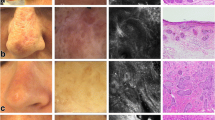Abstract
Chondrodermatitis nodularis helicis (CNH) is a benign auricular disease whose differentiation with nonpigmented tumors is mandatory. Clinical characteristics of CNH are well known, but there is no information about the dermoscopic features that could help differentiate CNH from squamous cell carcinoma and other non-melanoma skin cancers. To describe the dermoscopic appearance of CNH and to formulate a differential diagnostic model, we conducted a retrospective, single center, observational dermoscopic study on a sample of 189 biopsy-proven lesions: 25 CNH; 26 squamous cell carcinomas; 62 basal cell carcinomas and 76 other benign and malignant tumors. Univariate and multivariate analyses were conducted by logistic regression. The most significant dermoscopic finding for CNH was a peculiar global configuration (daisy pattern), consisting of white thick lines, radially arranged, converging to a central rounded yellow/brown clod (an erosion covered by keratin or sero-crust). This pattern achieved 92 and 98% of specificity for discriminating CNH with squamous cell carcinoma and basal cell carcinoma, respectively. In conclusion, dermoscopy is valuable for the diagnosis of CNH as a first screening tool because of a consistent global dermoscopic configuration (daisy pattern), consisting of radially arranged white thick lines surrounding a central rounded yellow/brown clod.






Similar content being viewed by others
References
Ackerman AB (1997) Histologic diagnosis of inflammatory skin diseases: an algorithmic method based on pattern analysis, 2nd edn. Williams & Wilkins, Baltimore
Chan HP, Neuhaus IM, Maibach HI (2009) Chondrodermatitis nodularis chronica helicis in monozygotic twins. Clin Exp Dermatol 34:358–359. https://doi.org/10.1111/j.1365-2230.2008.02915.x
Giacomel J, Zalaudek I, Marghoob AA (2015) Metaphoric and descriptive terminology in dermoscopy: lessons from the cognitive sciences. Dermatol Pract Concept 5:69–74. https://doi.org/10.5826/dpc.0502a11
Hurwitz RM (1987) Painful papule of the ear: a follicular disorder. J Dermatol Surg Oncol 13:270–274
Juul Nielsen L, Holkmann Olsen C, Lock-Andersen J (2016) Therapeutic options of chondrodermatitis nodularis helicis. Plast Surg Int. https://doi.org/10.1155/s4340168
Kittler H, Marghoob AA, Argenziano G et al (2016) Standardization of terminology in dermoscopy/dermatoscopy: results of the third consensus conference of the International Society of Dermoscopy. J Am Acad Dermatol 74:1093–1106. https://doi.org/10.1016/j.jaad.2015.12.038
Kittler H (2007) Dermatoscopy: introduction of a new algorithmic method based on pattern analysis for diagnosis of pigmented skin lesions. Dermatopathol Pract Concept 13:1
Kechichian E, Jabbour S, Haber R, Abdelmassih Y, Tomb R (2016) Management of chondrodermatitis nodularis helicis: a systematic review and treatment algorithm. Dermatol Surg 42:1125–1134. https://doi.org/10.1097/DSS.0000000000000817
Lallas A, Apalla Z, Argenziano G, Longo C, Moscarella E, Specchio F, Raucci M, Zalaudek I (2014) The dermatoscopic universe of basal cell carcinoma. Dermatol Pract Concept 4:11–24. https://doi.org/10.5826/dpc.0403a02
Lallas A, Giacomel J, Argenziano G, García-García B, González-Fernández D, Zalaudek I, Vázquez-López F (2014) Dermoscopy in general dermatology: practical tips for the clinician. Br J Dermatol 170:514–526. https://doi.org/10.1111/bjd.12685
Lallas A, Argenziano G, Apalla Z, Goruhant JY, Zaballos P, Di Lernia V, Moscarella E, Longo C, Zalaudek I (2014) Dermoscopic patterns of common facial inflammatory skin diseases. J Eur Acad Dermatol Venereol 28:609–614. https://doi.org/10.1111/jdv.12146
Magro CM, Frambach GE, Crowson AN (2005) Chondrodermatitis nodularis helicis as a marker of internal disease [corrected] associated with microvascular injury. J Cutan Pathol 32:329–333. https://doi.org/10.1111/j.0303-6987.2005.00317.x
Nadaud B, Depaepe L, Zaharia D, Balme B (2014) Chondrodermatitis nodularis helicis. Ann Dermatol Venereol 141:306–307. https://doi.org/10.1016/j.annder.2014.02.001
R Core Team (2015) R: a language and environment for statistical computing. R Foundation for Statistical Computing, Vienna
Rosendahl C, Cameron A, Argenziano G, Zalaudek I, Tschandl P, Kittler H (2012) Dermoscopy of squamous cell carcinoma and keratoacanthoma. Arch Dermatol 148:1386–1392. https://doi.org/10.1001/archdermatol.2012.2974
Rosendahl C, Cameron A, Tschandl P, Bulinska A, Zalaudek I, Kittler H (2014) Prediction without pigment: a decision algorithm for non-pigmented skin malignancy. Dermatol Pract Concept 4:59–66. https://doi.org/10.5826/dpc.0401a09
Sanchez-Martin J, Vazquez-Lopez F, Perez-Oliva N, Argenziano G (2012). Dermoscopy of small basal cell carcinoma: study of 100 lesions 5 mm or less in diameter. Dermatol Surg 38:947–950. https://doi.org/10.1111/j.1524-4725.2012.02358.x
Shah S, Fiala KH (2017) Chondrodermatitis nodularis helicis: a review of current therapies. Dermatol Ther. https://doi.org/10.1111/s12434
Sinz C, Tschandl P, Rosendahl C et al (2017) Accuracy of dermatoscopy for the diagnosis of nonpigmented cancers of the skin. J Am Acad Dermatol 77:1100–1109. https://doi.org/10.1016/j.jaad.2017.07.022
Wagner G, Liefeith J, Sachse MM (2011) Clinical appearance, differential diagnoses and therapeutical options of chondrodermatitis nodularis chronica helicis Winkler. J Dtsch Dermatol Ges 9:287–291. https://doi.org/10.1111/j.1610-0387.2011.07601.x
Wettlé C, Keller F, Will F, Lefebvre F, Cribier B (2013) Chondrodermatitis nodularis chronica helicis: a descriptive study of 99 patients. Ann Dermatol Venereol 140:687–692. https://doi.org/10.1016/j.annder.2013.07.002
Wolner ZJ, Bajaj S, Flores E, Carrera C, Navarrete-Dechent C, Dusza SW, Rabinovitz HS, Marchetti MA, Marghoob AA (2018) Variation in dermoscopic features of basal cell carcinoma as a function of anatomical location and pigmentation status. Br J Dermatol 178:e136–e137. https://doi.org/10.1111/bjd.15964
Zalaudek I, Giacomel J, Schmid K et al (2012) Dermatoscopy of facial actinic keratosis, intraepidermal carcinoma, and invasive squamous cell carcinoma: a progression model. J Am Acad Dermatol 66:589–597. https://doi.org/10.1016/j.jaad.2011.02.011
Acknowledgements
Statistical analysis and interpretation were completed with the assistance of the Scientific and Technical Services (statistical consultancy unit) from the University of Oviedo.
Funding
None.
Author information
Authors and Affiliations
Corresponding author
Ethics declarations
Conflict of interest
The authors declare that they have no conflict of interest.
Human rights
For this type of study formal consent is not required (retrospective study).
Informed consent
Informed consent was obtained from all individual participants included in the study.
Rights and permissions
About this article
Cite this article
García-García, B., Munguía-Calzada, P., Aubán-Pariente, J. et al. Dermoscopy of chondrodermatitis nodularis helicis. Arch Dermatol Res 310, 551–560 (2018). https://doi.org/10.1007/s00403-018-1844-6
Received:
Revised:
Accepted:
Published:
Issue Date:
DOI: https://doi.org/10.1007/s00403-018-1844-6




